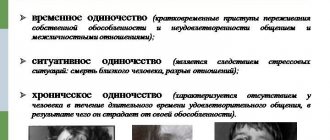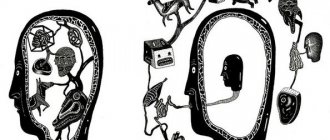The Zang Self-Rating Depression Scale is a test that identifies somatic, psychological, behavioral, and affective symptoms of depression. The test is designed to be self-administered and allows you to obtain a quantitative assessment of the severity of depression. In addition, the scale can be used as a screening tool, change monitoring and for clinical research purposes. This test is provided for educational purposes and does not constitute scientific material or professional medical advice. For diagnosis and treatment, please consult your doctor.
- Printed copy:
was by William W. K. Zung a psychotherapist at Duke University, in 1965 . (William W. K. Zung. A Self-Rating Depression Scale. Arch Gen Psychiatry 12:63-70. 1965.)
In Russia, the test was adapted by T.I. Balashova “Determination of the level of depression”
Description of the technique
Zung Self-Rating Depression Scale
(English: Zung Self-Rating Depression Scale) - a test for self-assessment of depression was developed at Duke University by psychiatrist Dr. William Zung. The test allows you to assess the level of depression of patients and determine the degree of depressive disorder. Using the Zung Scale, the subject or doctor can self-examine or screen for depression. The Zung Scale test has high sensitivity and specificity and allows you to avoid additional economic and time costs associated with medical examination of ethical problems.
The test takes into account 20 factors that determine four levels of depression. The test contains ten positively worded and ten negatively worded questions. Each question is rated on a scale from 1 to 4 (based on these responses: “never”, “sometimes”, “often”, “all the time”). The results are divided into four ranges:
- 25-49 Normal condition
- 50-59 Mild depression
- 60-69 Moderate depression
- 70 and above Severe depression
In our country, the test has been adapted in the Department of Narcology of the Research Institute named after. Bekhtereva T.I. Balashova.
Theoretical basis
The technique was created in 2004 at the NIPNI named after. Bekhterev, based on the statements of the MMPI, in order to create a questionnaire, firstly, a screening one, which does not require special knowledge when filling out, and secondly, a clinical one, reliably differentiating depression of the neurotic register from the endogenous one, the authors approached the selection of significant answers from a purely statistical position. This approach ensures the reliability of the technique and the identification of diagnostic points that can be difficult to predict from a clinical point of view. The ODS was standardized on three populations: patients with MDP (as individuals suffering from authentically endogenous depression), patients with neurotic depression and mentally healthy individuals. Each group was divided into men and women; selection of statements and standardization were carried out for each gender separately. Identification of persons suffering from depression within the framework of the test methodology is made on the basis of the “classical” combination of signs of the depressive triad, standard symptoms of somatic and behavioral “masks” of depression and “silent” symptoms of the anxiety spectrum. The second scale, differentiating the types of depression, is based on the difference between depression that is excitable, vegetatively unstable (neurotic in nature, according to the authors of the methodology) and depression that occurs with a decrease in energy potential (endogenous).
Procedure
The complete testing procedure with processing takes 20-30 minutes.
The subject marks the answers on the form.
Instructions
Read each of the sentences below carefully and cross out the appropriate number on the right depending on how you have been feeling lately. Don't overthink the questions because there are no right or wrong answers.
- A (1) – never or occasionally
- B (2) – sometimes
- C (3) – often
- D (4) – almost always or constantly
Self-diagnosis of depression using the Zunge scale
Depression is a common mental illness that most often occurs after negative events in a person’s life. However, there are times when a person develops depression without any apparent reason. As is known, depressive manifestations are very diverse and cover a wide range of symptoms. Emotional disturbances in depression manifest themselves in the form of a constant low mood, gradual loss of interests (up to apathy), feelings of hopelessness, low self-esteem and feelings of guilt. Disorders of the thought process in depression are characterized by a slowdown in associative processes, a deterioration in concentration, and a feeling of helplessness up to complete inability to work. In addition, depression is often accompanied by somatic symptoms. Most often, depressed patients experience problems with sleep and appetite, decreased sex drive, severe headaches and a variety of digestive problems.
In order for any person to independently determine the presence or absence of a depressive state, psychiatrist William Zunge developed a clinical test, today called the Zunge Self-Esteem Depression Scale. In other sources, this diagnostic technique is called the Low Mood-Subdepression Scale (LMS). This test is specially designed to differentiate all kinds of depressive conditions, as well as for group screening diagnostics. The Zunge test has also proven itself to be effective in primary diagnostics. In addition, this depression scale is used in drug trials.
This scale allows you not only to assess a person’s level of depression, but also to identify the degree of this disorder. The Zunge scale was first tested in 1965 in England. Currently, this popular questionnaire has been translated into more than thirty languages. The test is not only developed based on real diagnostic criteria for depression, but is also the result of a study of depressed patients. The severity of the disease is assessed based on a person's self-assessment. The Zunge scale is distinguished by its high reliability and ease of diagnostic procedure.
The questionnaire includes twenty questions, to each of which the subject gives an answer based on the frequency of manifestation of certain signs. Each question addresses one or another symptom of depression.
A total of 7 factors are measured:
- Emotional emptiness;
- Irritability or indecisiveness;
- Somatic symptoms;
- Suicidal thoughts;
- Psychomotor symptoms;
- Mood disorders;
- Specific signs.
Typically, the time required to self-assess depression using this scale takes about a minute. We suggest you take an adapted version of the Zunge test, which will only take you about 15 minutes.
When conducting self-diagnosis of depression using the Zunge Scale, it should be taken into account that self-assessment does not always give absolutely reliable results. Our psyche is designed in such a way that a person always wants to look better than he actually is. In addition, all depressed patients are characterized by a biased assessment of their condition. Therefore, for a more accurate diagnosis of depression, a person needs to contact an experienced psychotherapist or psychiatrist.
Processing the results
Depression level
(UD) is calculated by the formula:
UD=∑pr + ∑rev.
where ∑pr is the sum of crossed out numbers for “direct” statements No. 1,3,4,7,8,9,10,13,15,19;
∑rev. – the sum of the numbers “reverse” crossed out to statements No. 2, 5, 6, 11, 12,14,16,17, 18,20.
For example:
- Statement No. 2 has the number 1 crossed out, we put 4 points in the total;
- For statement No. 5, answer 2 is crossed out - we add 3 points to the total;
- For statement No. 6, answer 3 is crossed out - we add 2 points to the total;
- For statement No. 11, answer 4 is crossed out - add 1 point to the total, etc.
Depressive disorders
Depression is a state of complete depression and apathy. Most often it occurs against the background of long-term factors and frequent stressful situations, and extremely rarely appears simultaneously. Sometimes it is very difficult to suspect depression in a person, since it can be hidden behind a mask of bad mood and characteristics of temperament and character. In order to help a person, it is necessary to know the causes of the development of this disorder, as well as to know the symptoms and manifestations.
The reasons that form a depressed state include many factors that add up to each other. It is quite difficult to single out a single reason, but there are several most common points:
- prolonged stressful situations and psychological stress;
- loss of a loved one;
- breakup of relationships or family breakdown;
- failures at work or study, difficulties in career growth;
- lack of motivation;
- psychological trauma in childhood;
- low self-esteem, criticism and self-criticism;
- somatic factors and many others.
The symptoms of the disorder are no easier. As mentioned above, depression disguises itself as some other manifestations of a person’s emotional component. The most important symptoms that can be identified in a person with possible depression are:
- feeling of anxiety, despair;
- fatigue and emotional lability, regardless of circumstances;
- loss of interest in previously favorite activities;
- cases of panic attacks, feelings of fear (most often unfounded);
- decreased concentration and productivity;
- sleep disturbance or insomnia;
- lack of purpose for existence and suicidal tendencies (in clinical forms of depression).
By the way, it is also worth considering the fact that depression can be temporary, as a physical and psychological reaction to certain events. In such cases, a depressive state is a completely normal reaction, if after this independent recovery occurs.
Validation
Validation studies were carried out with the participation of patient populations of different ages, observed on an outpatient or inpatient basis. The content validity of the scale items was assessed by combining all symptoms. Comparative validity was examined using the Taylor Manifest Anxiety Scale (TMAS) and the Hamilton Anxiety Rating Scale (HARS). Discriminant sensitivity was assessed for each item and for the entire scale.
According to the Zung scale in the group of healthy subjects, the average score was 31.1 ± 1.3. Anxiety levels on this clinical scale are divided as follows: 20-40 points – low, 41-60 points – average, 61-80 points – high level of anxiety. The distribution of healthy individuals according to the Zung scale showed that the vast majority of subjects (91.8%) had a low level of anxiety, and 8.2% of healthy individuals had an average level of anxiety. No persons with high levels of anxiety were identified among healthy subjects. Higher scores on the Zung self-assessment anxiety scale were determined in patients with neuroses (compared to the healthy population (p
Hospital Anxiety and Depression Scale HADS
18.02.201918.02.2019|
adminadmin|
A test for anxiety disorders and depression will help determine their presence and severity.
Part I (Anxiety Assessment)
- I feel tense, I feel uneasy 3 - all the time 2 - often 1 - from time to time, sometimes 0 - not at all
- I feel afraid, it seems as if something terrible is about to happen 3 - definitely so, and the fear is very great 2 - yes, it is so, but the fear is not very great 1 - sometimes, but it doesn’t bother me 0 - not at all I don't feel it
- Worrying thoughts are running through my head 3 - all the time 2 - most of the time 1 - occasionally and not so often 0 - only sometimes
- I can easily sit down and relax 0 - definitely true 1 - probably true 2 - only occasionally true 3 - not at all
- I experience internal tension or trembling 0 - not at all 1 - sometimes 2 - often 3 - very often
- I feel restless, I constantly need to move 3 - definitely true 2 - probably true 1 - only to some extent true 0 - not at all
- I have a sudden feeling of panic 3 - very often 2 - quite often 1 - not so often 0 - not at all
Calculate the number of points, compare with the values:
- 1-7 points – normal
- 8-10 points – subclinically expressed anxiety disorder
- 10 points and above – clinically significant anxiety disorder
Part II (assessment of depression level)
- What brought me great pleasure, and now gives me the same feeling 0 - definitely true 1 - probably true 2 - only to a very small extent true 3 - not at all true
- I am able to laugh and see the funny in this or that event 0 - definitely this is so 1 - probably this is so 2 - only to a very small extent this is so 3 - not at all capable
- I feel cheerful 3 - not at all 2 - very rarely 1 - sometimes 0 - almost all the time
- It seems to me that I began to do everything very slowly 3 - almost all the time 2 - often 1 - sometimes 0 - not at all
- I don't take care of my appearance 3 - that's definitely true 2 - I don't spend as much time on it as I should 1 - maybe I'm spending less time on it 0 - I take care of myself the same way as before
- I believe that my activities (activities, hobbies) can bring me a sense of satisfaction 0 - exactly the same as usual 1 - yes, but not to the same extent as before 2 - much less than usual 3 - I don’t think so at all
- I can enjoy a good book, radio or television program 0 - often 1 - sometimes 2 - rarely 3 - very rarely
Count the number of points, compare the result:
- 1-7 points – normal
- 8-10 points – subclinically expressed depression
- 10 points and above – clinically significant depression
If the total score for any part of the scale is 8 points or more, you need help.










